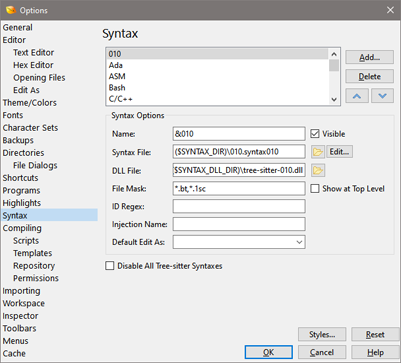
Choose the character set using the Character Set drop-down list and if the Add BOM to New Files toggle is enabled, a Byte-Order Mark will be added to files when they are created (note that Byte-Order Marks are only used for Unicode or UTF-8 files and see Byte-Order Marks for more information). When using Fixed Width mode the field to the right of the Line Width drop-down list is used to enter the number of bytes per line. If the Edit As is for a hex-based file the Line Width drop-down list can be used to indicate Fixed Width or Auto Width. All other Character Sets - Linefeed choices include CRLF (DOS - 0x0D0A), LF (UNIX - 0x0A), or CR (Mac - 0x0D).EBCDIC - Linefeed choices include CRLF (DOS - 0x0D25), LF (UNIX - 0x25), or NEL (0x15).The linefeeds to choose depend upon which type of character set is chosen with the Character Set option: If the Edit As is for a text-based file the Default Linefeeds drop-down list is used to choose which linefeeds to insert when a new file is created using this Edit As. If the Use Default toggle is disabled, a custom font can be set for the Edit As by clicking the Font button and using the standard font dialog to select a font. If the Use Default toggle is enabled, the Edit As uses either the default text editor font or the default hex editor font from the Font Options dialog. 010 Editor can remember the last used Edit As for a file so this method of applying an Edit As only applies to files that have not been opened before in 010 Editor. Note that if no file mask matches the file, 010 Editor will automatically try to detect the correct Edit As to use (see Opening Files in the Editor Options dialog for more options). If multiple masks match a file, the last matching Edit As in the list will be applied to the file. For example, use '*.bmp' to match all BMP files, or 'C:\temp\*.0?' to match all files under the temporary directory with an extension starting with '0'. The file mask may contain the characters '*' or '?' to indicate wildcards and is not case sensitive. When a file is opened, it is automatically assigned an Edit As based on the Mask field. Clicking the Visible toggle provides any easy way to show or hide the Edit As in the menu. This name will appear under the ' View > Edit As' menu and in the status bar.

Enter a name for the Edit As in the Name field. Clicking the up or down arrows will change the position of the entry in the list.Īfter an Edit As is selected from the list, options for that Edit As will be displayed in the Edit As Options box. Select an item from the list and click Delete to remove an Edit As.

Clicking the New button will generate a new Edit As and you must specify whether you would like to create a text-based Edit As or a hex-based Edit As. Access this dialog by clicking the ' Tools > Options.' menu option and selecting Edit As from the list or by clicking ' View > Edit As > View Edit As List.'.Ī list of all available Edit As choices is displayed at the top of the dialog. The Edit As Options dialog allows modifying this list. Each file that is loaded is assigned an Edit As from the Edit As list either by a file mask or by auto-detect. Consult Using Edit As for more information.


The C keyword ' struct' can be used in a Template to define a hierarchical data structure when parsing a file. Installing Files on Open from the Repository.


 0 kommentar(er)
0 kommentar(er)
